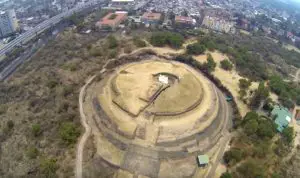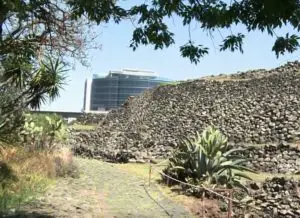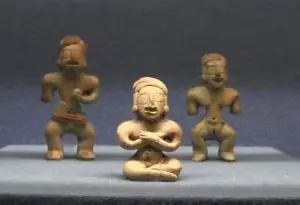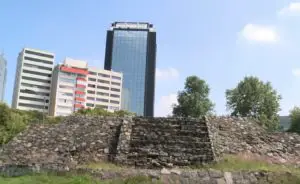Podcast: Play in new window | Download
Subscribe: Apple Podcasts | RSS
 Most people are at least vaguely familiar with the story of the ancient Roman city of Pompeii. It was a prosperous and thriving port near the modern Italian city of Naples on the slopes of Mount Vesuvius. Vesuvius even in modern times is an active volcano and on one day in August in 79 AD the mountain erupted and buried the cities of Pompeii and Herculaneum under many feet of ash and rock. People scrambled to leave the city or hide out in their homes, and many didn’t make it, either being killed in the fallout from the mountain’s explosion or from the volcano’s toxic gasses. Books have been written and movies have been made about this tragic event. Even those with a moderate to intermediate interest in Mexican history and archaeology are unaware that ancient Mexico had its own version of Mount Vesuvius and Pompeii in the form of a volcano called Mount Xitle and a city called Cuicuilco.
Most people are at least vaguely familiar with the story of the ancient Roman city of Pompeii. It was a prosperous and thriving port near the modern Italian city of Naples on the slopes of Mount Vesuvius. Vesuvius even in modern times is an active volcano and on one day in August in 79 AD the mountain erupted and buried the cities of Pompeii and Herculaneum under many feet of ash and rock. People scrambled to leave the city or hide out in their homes, and many didn’t make it, either being killed in the fallout from the mountain’s explosion or from the volcano’s toxic gasses. Books have been written and movies have been made about this tragic event. Even those with a moderate to intermediate interest in Mexican history and archaeology are unaware that ancient Mexico had its own version of Mount Vesuvius and Pompeii in the form of a volcano called Mount Xitle and a city called Cuicuilco.
Long before the Aztecs arrived in the Valley of Mexico and even before the rise of the Toltecs before them, there existed small kingdoms around the basin’s system of lakes collectively known as Lake Texcoco. Archaeologists believe that settled farming communities began in the area sometime around 1200 BC. Tribes gathered in small villages to grow maize, beans, amaranth, squash and peppers. They also exploited forest and lake resources, which were abundant and close by. With a rise in population at these small settlements came task specialization and then a social hierarchy. One of the first of the powerful regional centers to emerge near the shores of Lake Xoximilco in the southwestern part of the Valley of Mexico was Cuicuilco. Archaeologists date the first settlement at the site to between 1400 BC and 1200 BC. The early farming town took advantage of the fertile volcanic soils and the rich sediment from a river delta formed from the runoff of the waters from Zacatépetl and Zacayuca, two large hills nearby. Cuicuilco grew as a ceremonial center in what archaeologists call the Preclassic period and was most likely the first of its kind in the Mexican highlands. The circular pyramid that dominates the ruins today is thought to be the earliest pyramidal structure ever built in ancient Mexico. The 2,000-year-old public works project measures 405 feet in diameter at the base and 60 feet high. The other large buildings there indicate strict social organization and task specialization. Researchers have identified four different types of settlements at Cuicuilco based on social or economic status or some combination of the two. Avenues radiated outward from the central civic-ceremonial center and neighborhoods were clustered around small plazas. Cuicuilco also had a complex system of irrigation with canals and ditches found throughout the city. At its height, the  site had a population of about 20,000 people making it one of the most populated places in the region by about the year 500 BC. Archaeological evidence found at the site shows that Cuicuilco had contact through trade with the Chupícuaro culture to the west and the Olmec area many hundreds of miles to the east and south. The site developed its own ceramic tradition and examples of that tradition have been found in other ruins in the Valley of Mexico and in other locations beyond the Mexican highlands, indicating long distance trade. Cuicuilco-manufactured pottery has been discovered as far away as the Olmec city of Monte Albán located in the modern Mexican state of Oaxaca. Fortifications at the site show that Cuicuilco was not without its share of enemies. As the population exploded in the Valley of Mexico in the First Century BC many of the small kingdoms around Lake Texcoco competed for resources, including the scarcest resource among them: land. Power centers rose and took over smaller villages and weaker kingdoms. Archaeologists believe that sometime around 200 BC Cuiculco took over a very powerful neighbor, a kingdom based out of the city of Tlatilco which also included the rich agricultural city of Tlapacoya. Although relations with its neighbors were sometimes tense, researchers believe that Cuicuilco also served not only as a seat of great political power, but as a center of religious power. Some archaeologists believe that Cuicuilco’s main purpose was that of pilgrimage site, and this is one of the reasons that many foreign goods, specifically religious-themed items, have shown up in the archaeological record. In the early years BC the city-state’s biggest rival was located some 45 miles to the northeast, an emerging pyramid-building powerhouse called Teotihuacán. For more information on Teotihuacán, please see Mexico Unexplained episode number 45. https://mexicounexplained.com/teotihuacan-lost-city-gods/
site had a population of about 20,000 people making it one of the most populated places in the region by about the year 500 BC. Archaeological evidence found at the site shows that Cuicuilco had contact through trade with the Chupícuaro culture to the west and the Olmec area many hundreds of miles to the east and south. The site developed its own ceramic tradition and examples of that tradition have been found in other ruins in the Valley of Mexico and in other locations beyond the Mexican highlands, indicating long distance trade. Cuicuilco-manufactured pottery has been discovered as far away as the Olmec city of Monte Albán located in the modern Mexican state of Oaxaca. Fortifications at the site show that Cuicuilco was not without its share of enemies. As the population exploded in the Valley of Mexico in the First Century BC many of the small kingdoms around Lake Texcoco competed for resources, including the scarcest resource among them: land. Power centers rose and took over smaller villages and weaker kingdoms. Archaeologists believe that sometime around 200 BC Cuiculco took over a very powerful neighbor, a kingdom based out of the city of Tlatilco which also included the rich agricultural city of Tlapacoya. Although relations with its neighbors were sometimes tense, researchers believe that Cuicuilco also served not only as a seat of great political power, but as a center of religious power. Some archaeologists believe that Cuicuilco’s main purpose was that of pilgrimage site, and this is one of the reasons that many foreign goods, specifically religious-themed items, have shown up in the archaeological record. In the early years BC the city-state’s biggest rival was located some 45 miles to the northeast, an emerging pyramid-building powerhouse called Teotihuacán. For more information on Teotihuacán, please see Mexico Unexplained episode number 45. https://mexicounexplained.com/teotihuacan-lost-city-gods/
Sometime around the year 50 BC the whole world changed for the kingdoms of central Mexico. To this day, intermittent volcanic eruptions are not uncommon in what is now known as the Trans-Mexican Volcanic Belt, which is comprised of a series of dormant and active volcanoes spanning the country of Mexico. It’s a very rare event, though, when the people of the region experience “The Big One.” Some 130 years before the eruption of Mount Vesuvius in Classical Roman Italy, a volcano named Xitle began rumbling on the southwestern fringes of the Valley of Mexico. One can only imagine the blackening skies, the shaking earth, the deafening noise of the eruption. In the city of Cuicuilco did the people turn to the priests and the nobility for answers? Did they feel that they were being punished for their excesses and maybe their pride? Could anything stop the angry volcano? The end result was a fast-moving lava spewing from the volcano Xitle, whose  Nahuatl name literally means “belly button.” Perhaps it only took a few days for most of the city of Cuicuilco to be covered in a layer of lava that was 33 feet deep in some places. Like Pompeii, Cuicuilco also had a smaller city nearby meet the same fate with it: the city of Copilco. Another smaller farming village under Cuicuilco control called Quiahuac was also severely damaged by the eruption of Xitle. The repercussions of this event were immediate and dramatic. The destruction of the major part of the Cuicuilco kingdom caused a mass exodus of the survivors. Many residents of this formerly powerful political entity immigrated to Toluca or the kingdom’s main rival in the region, Teotihuacán. Teotihuacán not only gained some of the skilled craftsman, priests and administrators of their former enemy, from a political standpoint there was no more enemy. This unfortunate event for Cuicuilco made Teotihuacán the undisputed number one power in the Valley of Mexico. From here, the sky was the limit, and the rest was history.
Nahuatl name literally means “belly button.” Perhaps it only took a few days for most of the city of Cuicuilco to be covered in a layer of lava that was 33 feet deep in some places. Like Pompeii, Cuicuilco also had a smaller city nearby meet the same fate with it: the city of Copilco. Another smaller farming village under Cuicuilco control called Quiahuac was also severely damaged by the eruption of Xitle. The repercussions of this event were immediate and dramatic. The destruction of the major part of the Cuicuilco kingdom caused a mass exodus of the survivors. Many residents of this formerly powerful political entity immigrated to Toluca or the kingdom’s main rival in the region, Teotihuacán. Teotihuacán not only gained some of the skilled craftsman, priests and administrators of their former enemy, from a political standpoint there was no more enemy. This unfortunate event for Cuicuilco made Teotihuacán the undisputed number one power in the Valley of Mexico. From here, the sky was the limit, and the rest was history.
Because Cuicuilco was so important, people began returning to the site of the formerly great city a few generations after the catastrophic eruption of Mount Xitle. Some archaeologists believe that most of the people returning to the area did so for religious reasons and during the early centuries AD building at the site began again. In the archaeological record at the time there seems to be an abundance of fire god representations which would seem fitting for this case. While people began to repopulate the area and Cuicuilco experienced a mini renaissance of sorts, the grumbling volcano had other plans. A series of small eruptions sometime between 250 and 400 AD put all major rebuilding plans to rest.
By the time the Aztecs arrived in the Valley of Mexico in the 1300s a small settlement of Nahua-speaking people existed at the site. The people called the village “Cuicuilco” which in Nahuatl means “Place of song and dance.” The Spanish who arrived at the site some 200 years later noted that people were making offerings of small ceramic figurines into the ponds surrounding the village of Cuicuilco. Neither the Aztecs nor the new Spanish overlords knew of the ruins underneath the basalt that was once the lava flow from Mount Xitle, but the current inhabitants knew of the sacredness of the place, as it was preserved in the local collective memory for well over a millennium. In the 1540s, the Spanish conquistador Bernal Díaz del Castillo, who wrote hundreds of pages on the conquest of the Aztecs and the early days of New Spain, was given a grant over the lands encompassing the former kingdom of Cuicuilco. The area was a backwater for many years  until the monster called Mexico City eventually grew so large that it crept up to the margins of this once-great ancient city. It was only in the 1920s when the massive architecture of the heart of Cuicuilco first saw light of day from underneath the old lava flows. Archaeologists were astonished to find the massive circular pyramid and other large structures. Besides a major dig in 1939, very little activity occurred at the Cuicuilco ruins during the 20th Century. Archaeologists at the time did not know what they were dealing with, how old the site was or what area it covered. The ruins had two conditions that worked against any thorough research being conducted at the site: the thick lava rock layer and pressures on the land made by developers as the area became increasingly a part of the greater Mexico City megalopolis. For the 1968 Mexico City Olympics part of the archaeological site of Cuicuilco was destroyed to make way for the Olympic Village. Some 300,000 pieces of pottery and figurines were unearthed during the building process and an untold number of structures were bulldozed to make way for the world’s top athletes. Today, the former Olympic Village serves as low-income housing. Pressure to build on former archaeological areas in and around Cuicuilco continued all the way through the 1990s. Many buildings belonging to UNAM, the National Autonomous University of Mexico, were built on the edges of the site in the 1970s and 1980s. As late as 1997, parts of ancient Cuicuilco were developed into what is now known as the Cuicuilco Commercial Plaza, with its crown jewel the modern Telmex Building dominating the regional skyline. The archaeological park containing the 60-foot-tall central pyramid appears somewhat out of place in this seemingly endless urban jungle. It is a race against time to do the much-needed work to get a more complete understanding of this very ancient and magnificent place.
until the monster called Mexico City eventually grew so large that it crept up to the margins of this once-great ancient city. It was only in the 1920s when the massive architecture of the heart of Cuicuilco first saw light of day from underneath the old lava flows. Archaeologists were astonished to find the massive circular pyramid and other large structures. Besides a major dig in 1939, very little activity occurred at the Cuicuilco ruins during the 20th Century. Archaeologists at the time did not know what they were dealing with, how old the site was or what area it covered. The ruins had two conditions that worked against any thorough research being conducted at the site: the thick lava rock layer and pressures on the land made by developers as the area became increasingly a part of the greater Mexico City megalopolis. For the 1968 Mexico City Olympics part of the archaeological site of Cuicuilco was destroyed to make way for the Olympic Village. Some 300,000 pieces of pottery and figurines were unearthed during the building process and an untold number of structures were bulldozed to make way for the world’s top athletes. Today, the former Olympic Village serves as low-income housing. Pressure to build on former archaeological areas in and around Cuicuilco continued all the way through the 1990s. Many buildings belonging to UNAM, the National Autonomous University of Mexico, were built on the edges of the site in the 1970s and 1980s. As late as 1997, parts of ancient Cuicuilco were developed into what is now known as the Cuicuilco Commercial Plaza, with its crown jewel the modern Telmex Building dominating the regional skyline. The archaeological park containing the 60-foot-tall central pyramid appears somewhat out of place in this seemingly endless urban jungle. It is a race against time to do the much-needed work to get a more complete understanding of this very ancient and magnificent place.
REFERENCES
INAH Website (in Spanish)
